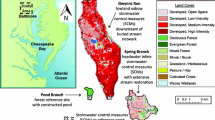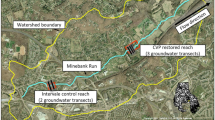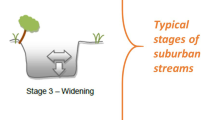Abstract
In large part driven by total maximum daily load (TMDL) mandates, the restoration community in the Chesapeake Bay region has been implementing novel best management practices (BMPs) and stream restoration designs in urban areas, such as regenerative stream/stormwater conveyance (RSC) structures and stream-wetland complexes (SWCs). However, the nutrient and sediment reduction efficiencies of these novel designs are virtually unknown, and the possibility of increasing riverine flow in the Chesapeake Bay watershed associated with climate change this century necessitates an evaluation of their performance to develop and utilize those that optimize reductions in nutrient and sediment fluxes. We compare pre- and post-construction loads (total nitrogen (TN), total phosphorus (TP), and total suspended solids (TSS)) from RSCs (i.e., upland BMPs) and a SWC (i.e., stream restoration) constructed at the outflow of a highly developed watershed in the Coastal Plain physiographic province of Maryland. The largest of the two RSCs performed best in relation to expected nutrient and sediment reductions because of superior water retention capability. By the length of river reach restored, the SWC attained from 79 to 88% of its N reduction TMDL goal, but only 19 to 23 and 2.7 to 3.1% for TP and TSS, respectively; by watershed area, % attainments of TMDL goals were much lower. Results indicate that SWCs have the potential to curtail N loading from developed catchments, but additional water quality benefits may be limited. Climate change projections indicate that there will be an increased frequency of larger-volume storms that will result in an increase in stormflow runoff from urban areas, and increased pollutant loads will likely curtail potential gains made by efforts to achieve TMDL goals. Given the large-scale implementation of BMPs currently underway to accommodate the Chesapeake Bay TMDL, the restoration community needs to adopt a concerted strategy of building climate resilience into many types of urban BMPs to help attain and maintain loads at TMDL levels in anticipation of a progressively wetter climate throughout this century.









Similar content being viewed by others
References
Abtew, W. and A. Melesse (eds) 2012. Wetland evapotranspiration (pp. 93–108). In Evaporation and evapotranspiration, measurements and estimations, eds. W. Abtew and A.M. Melesse, 202. Springer: Dordrecht, The Netherlands.
Anne Arundel Co. Department of Public Works. 2012. Chesapeake Bay TMDL phase II watershed implementation plan manual (p. 36); Table 2.3 Core Urban Stormwater Strategy. Tier I.
Blunden, J., and D. Arndt. 2015. State of the climate in 2014. Bull. Amer. Meteor. Soc. 96 (7): S1–S267.
Bouraoui, F., L. Galbiati, and G. Bidoglio. 2002. Climate change impacts on nutrient loads in the Yorkshire Ouse catchment (U.K.). Hydrology and Earth System Sciences 6 (2): 197–209.
Brown, T., J. Berg & K. Underwood. 2010. Regenerative stormwater conveyance: an innovative approach to meet a range of stormwater management and ecological goals, pp. 3399–3413. World Environmental and Water Resources Congress. American Society of Civil Engineers.
Bunn, S.E., P.M. Davies, and T.D. Mosisch. 1999. Ecosystem measurements of river health and their response to riparian and catchment degradation. Freshwater Biology 41: 333–345.
Butcher, J., T. Johnson, D. Nover, and S. Sarkar. 2014. Incorporating the effects of increased atmospheric CO2 in watershed model projections of climate change impacts. Journal of Hydrology 513: 322–334.
Caldwell, P.V., G. Sun, S.G. McNulty, E.C. Cohen, and J.A. Moore Myers. 2012. Impacts of impervious cover, water withdrawals, and climate change on river flows in the conterminous. U.S. Hydrol. Earth Syst. Sci. 16: 2839–2857.
Cox, P., and D. Stephenson. 2007. A changing climate for prediction. Science 317: 207–208.
Craig, L.S., M.A. Palmer, D.C. Richardson, S. Filoso, E.S. Bernhardt, B.P. Bledsoe, M.W. Doyle, P.M. Groffman, B.A. Hassett, S.S. Kaushal, P.M. Mayer, S.M. Smith, and P.R. Wilcock. 2008. Stream restoration strategies for reducing river nitrogen loads. Frontiers in Ecol. Environ. 6: 529–538.
Filoso, S., S. Smith, M. Williams, and M. Palmer. 2015. The efficacy of constructed stream-wetland complexes at reducing the flux of suspended solids to Chesapeake Bay. Environmental Science and Technology 49 (15): 8986–8994 (ISSN: 1520-5851). doi:10.1021/acs.est.5b00063.
Filoso, S., and M.A. Palmer. 2011. Assessing stream restoration effectiveness at reducing nitrogen export to downstream waters. Ecol. Applic. 21 (6): 1989–2006.
Fischbach, J.R., R.J. Lempert, E. Molina-Perez, A.A. Tariq, M.L. Finucane and F. Hoss. 2015. Managing water quality in the face of uncertainty a robust decision making demonstration for EPA’s National Water Program, Rand Corporation, 135 p.
Gordon, N.D., T.A. McMahon, B.L. Finlayson, C.J. Gippel, and R.J. Nathan (2004) Stream hydrology: an introduction for ecologists, 2nd ed., John Wiley and Sons Ltd, West Sussex.
Groisman, P.Y., R.W. Knight, T.R. Karl, D.R. Easterling, B. Sun, and J.H. Lawrimore. 2004. Contemporary changes of the hydrological cycle over the contiguous United States: trends derived from in situ observations. J. Hydrometeorology 5: 64–85.
Hall, R.O. Jr., J.L. Tank, D.J. Sobota, P.J. Mulholland, J.M. O’Brien, W.K. Dodds, J.R. Webster, H.M. Valett, G.C. Poole, B.J. Peterson, J.L. Meyer, W.H. McDowell, S.L. Johnson, S.K. Hamilton, N.B. Grimm, S.V. Gregory, C.N. Dahm, L.W. Cooper, L.R. Ashkenas, S.M. Thomas, R.W. Sheibley, J.D. Potter, B.R. Niederlehner, L.T. Johnson, A.M. Helton, C. Crenshaw, A.J. Burgin, M.J. Bernot, J.J. Beaulieu, and C. Arango. 2009. Nitrate removal in stream ecosystems measured by 15N addition experiments. 1. Total uptake. Limno. Oceano. 54 (3): 653–665.
Hawkins, E., and R. Sutton. 2009. The potential to narrow uncertainty in regional climate predictions. Bull. Am. Meteoro. Soc. 90: 1095–1107.
IPCC. 2013. Summary for policymakers. In: climate change 2013: the physical science basis. In Contribution of working group I to the fifth assessment report of the intergovernmental panel on climate change, ed. T.F. Stocker, D. Qin, G.-K. Plattner, M. Tignor, S.K. Allen, J. Boschung, A. Nauels, Y. Xia, V. Bex, and P.M. Midgley. Cambridge: Cambridge University Press.
Karl, T.R., J.M. Melillo and T.C. Peterson (eds.) (2009) Global climate change impacts in the United States. Cambridge University Press, 2009.
Keenan, T.F., D.Y. Hollinger, G. Bohrer, D. Dragoni, J.W. Munger, H.P. Schmid, and A.D. Richardson. 2013. Increase in forest water-use efficiency as atmospheric carbon dioxide concentrations rise. Nature 2013 499 (7458): 324–327.
Kunkel, K.E., L.E. Stevens, S.E. Stevens, Sun, L., E. Janssen, D. Wuebbles, J. Rennells, A. DeGaetano, J.G. Dobson. 2013. Regional climate trends and scenarios for the U.S. National Climate Assessment, Part 1. Climate of the Northeast U.S., NOAA Technical Report NESDIS 142-1. U.S. Department of Commerce, Washington, D.C., 79 pp.
Lempert, R.J., D.G. Groves, S.W. Popper, et al. 2006. A general, analytic method for generating robust strategies and narrative scenarios. Management Science 52 (4): 514–528.
Liang, N., E.E. Riddle, and R.S. Bradley. 2015. Projected changes in climate extremes over the northeastern United States. Journal of Climate 28 (8): 3289–3310.
Melillo, J.M., T.C. Richmond and G.W. Yohe. .2014. Climate change impacts in the United States: the third national climate assessment. U.S. Global Change Research Program, 841 pp. doi: 10.7930/J0Z31WJ2.
Mulholland, P.J., A.M. Helton, G.C. Poole, R.O. Hall, S.K. Hamilton, B.J. Peterson, J.L. Tank, L.R. Ashkenas, L.W. Cooper, C.N. Dahm, W.K. Dodds, S.E.G. Findlay, et al. 2008. Stream denitrification across biomes and its response to anthropogenic nitrate loading. Nature 452: 202–205. doi:10.1038/nature06686.
Mulholland, P.J., R.O. Hall Jr., D.J. Sobota, W.K. Dodds, S. Findlay, N.B. Grimm, S.K. Hamilton, W.H. McDowell, J.M. O’Brien, J.L. Tank, L.R. Ashkenas, L.W. Cooper, C.N. Dahm, S.V. Gregory, S.L. Johnson, J.L. Meyer, B.J. Peterson, G.C. Poole, H.M. Valett, J.R. Webster, C. Arango, J.J. Beaulieu, M.J. Bernot, A.J. Burgin, C. Crenshaw, A.M. Helton, L.T. Johnson, B.R. Niederlehner, J.D. Potter, R.W. Sheibley, and S.M. Thomas. 2009. Nitrate removal in stream ecosystems measured by 15N addition experiments. 2. Denitrification. Limno. Oceano. 54 (3): 666–680.
Najjar, R.G., C.R. Pyke, M.B. Adams, D. Breitburg, C. Hershner, M. Kemp, and R. Wood. 2010. Potential climate-change impacts on the Chesapeake Bay. Estuar., Coast Shelf Sci. 86 (1): 1–20.
Najjar, R.G., L. Patterson, and S. Graham. 2009. Climate simulations of major estuarine watersheds in the Mid-Atlantic region of the United States. Climatic Change 95: 139–168.
Newcomer-Johnson, T.A., S.S. Kaushal, P.M. Mayer, R.M. Smith, and G.M. Sivirichi. 2016. Nutrient retention in restored streams and rivers: a global review and synthesis. Water 8 (4): 1–28. doi:10.3390/w8040116.
NOAA. 1982. Mean monthly, seasonal, and annual pan evaporation for the United States, Technical Report NWS 34, 91 p.
Palmer, M.A., S. Filoso, and R.M. Fanelli. 2014. From ecosystems to ecosystem services: stream restoration as ecological engineering. Ecol. Engin. 65: 62–70.
Peterjohn, W.T., and D.L. Correll. 1984. Nutrient dynamics in an agricultural watershed: observations on the role of a riparian forest. Ecology 65: 1466–1475.
Peterson, B.J., W.M. Wollheim, P.J. Mulholland, J.R. Webster, J.L. Meyer, T.E. Tank, W.B. Marti, H.M. Bowden, A.E. Vallett, W.H. Hershey, et al. 2001. Control of nitrogen export from watersheds by headwater streams. Science 292: 86–90. doi:10.1126/science.1056874.
Pennino, M.J., S.S. Kaushal, P.M. Mayer, R.M. Utz, and C.A. Cooper. 2016. Stream restoration and sewers impact sources and fluxes of water, carbon, and nutrients in urban watersheds. Hydrology and Earth System Sciences 20: 3419–3439. doi:10.5194/hess-20-3419-2016.
Pyke, C., M. Warren, T. Johnson, J. LaGro Jr., J. Scharfenberg, P. Groth, R. Freed, W. Schroeer, and E. Main. 2011. Assessment of low impact development for managing stormwater with changing precipitation due to climate change. Landsc. Urb Plan. 103 (2): 166–173.
Pyke, C.R., R.G. Najjar, M.B. Adams, D. Breitburg, M. Kemp, C. Hershner, R. Howarth, M. Mulholland, M. Paolisso, D. Secor, K. Sellner, D. Wardrop, and R. Wood. 2008. Climate change and the Chesapeake Bay: state-of-the-science review and recommendations. A report from the Chesapeake Bay Program Science and Technical Advisory Committee (STAC), Annapolis, MD. 59 pp.
Raisanen, J. 2007. How reliable are climate models? Tellus 59A: 2–29.
Reger, J. and E.T. Cleaves. 2008. Physiographic map of Maryland. Maryland Geological Survey. Baltimore, Maryland.
Roberts, B.J., P.J. Mulholland, and W.R. Hill. 2007. Multiple scales of temporal variability in ecosystem metabolism rates: results from 2 years of continuous monitoring in a forested headwater stream. Ecosystems 10: 588–606. doi:10.1007/s10021-007-9059-2.
Sarewitz, D., R.A. Pielke Jr., and R. Byerly Jr. 2000. Introduction: death, taxes, and environmental policy. In Prediction: science, decision making, and the future of nature, ed. D. Sarewitz, R.A. Pielke Jr., and R. Byerly Jr. Washington, DC: Island Press.
Schneider, D.W. 1996. Effects of European settlement and land use on regional patterns of similarity among Chesapeake Forests. Bull. Torrey Botan. Club 123 (3): 223–239 . doi:10.2307/2996798.Torrey Botanical Society
Selvakumar, A., T.P.O. Connor, and S.D. Struck. 2010. Role of stream restoration on improving benthic macroinvertebrates and in-stream water quality in an urban watershed: case study. Journal of Environmental Engineering 136 (1): 127–139.
U.S. EPA. 2013. Watershed modeling to assess the sensitivity of streamflow, nutrient, and sediment loads to potential climate change and urban development in 20 U.S. watersheds (final report). U.S. Environ. Protection Agency, Washington, DC, EPA/600/R-12/058F.
Volkery, A., and T. Ribeiro. 2009. Scenario planning in public policy: understanding use, impacts and the role of institutional context factors. Technol. Forec. Soc. Change 76 (9): 1198–1207.
Williams, M.R. 2014. Managing stormwater runoff from urban areas in consideration of predicted climate change impacts in the Mid-Atlantic region. Am. Geophys. Union.
Williams, M.R. and S. Filoso. 2016 The capacity of regenerative stream/stormwater conveyance (RSC) structures to reduce pollutant loads from headwater catchments. Final report to the District Department of Energy and Environment (DOEE), 34 p.
Williams, M.R. and S. Filoso. 2015. Monitoring the effectiveness of stormwater treatment practices at reducing pollutant loads to receiving waters in the Magothy Watershed. Final report to Anne Arundel County. 34 p.
Williams, M.R., B. Wessel, and S. Filoso. 2016. Sources of iron (Fe) and factors regulating the development of flocculate from Fe-oxidizing bacteria in regenerative stormwater conveyance structures. Ecological Engineering 95: 723–737.
Williams, M.R., S. Filoso, B.J. Longstaff, and W.C. Dennison. 2010. Long-term trends of water quality and biotic metrics in Chesapeake Bay: 1986 to 2008. Estuaries and Coasts 33: 1279–1299. doi:10.1007/s12237-010-9333-y.
Yactayo, G., L. Linker and G. Bhatt (2015) Hydrologic trend analysis of the Chesapeake Bay TMDL. Am. Geophys. Union.
Acknowledgements
Thanks to J. Li, J. Kames, and D. Gray for the field and lab assistance; A. Bayard for GIS analysis; P. Wang for the estuarine model output; and L. Linker and G. Shenk for facilitating the modeling efforts. Support for this project was provided by Anne Arundel County (grant no. 8514) and the National Oceanic and Atmospheric Administration (NOAA, grant no. NA10OAR4310221). This manuscript benefited from the constructive comments of Margaret Palmer and two anonymous reviewers.
Author information
Authors and Affiliations
Corresponding author
Additional information
Communicated by Mark J. Brush
Electronic supplementary material
ESM 1
(DOCX 613 kb)
Rights and permissions
About this article
Cite this article
Williams, M.R., Bhatt, G., Filoso, S. et al. Stream Restoration Performance and Its Contribution to the Chesapeake Bay TMDL: Challenges Posed by Climate Change in Urban Areas. Estuaries and Coasts 40, 1227–1246 (2017). https://doi.org/10.1007/s12237-017-0226-1
Received:
Revised:
Accepted:
Published:
Issue Date:
DOI: https://doi.org/10.1007/s12237-017-0226-1




